Beijing has a very old, difficult and extremely interesting history. The city has many grand charms that attract tourists from around the world. If you are lucky enough to be in this wonderful city, Tiananmen Square must be number one in the list of mandatory places to visit first.
Despite the fact that its middle name is Square of Heavenly Peace, peace has never been here. Everything that happened in Beijing, all the famous people and great rulers were related to Tiananmen. Since ancient times, this area was the main place of public meetings, various celebrations, parades and government presence. You can certainty say that the Tiananmen Square is the real heart of Beijing, which has been beating since the time of the Empire to present days.
In addition, Tiananmen Square is the largest square in the world. Nowadays its length is 880 meters, and the width is 500 meters. While on the Square Tiananmen, you can admire not only its scale and grandeur, but also other surrounding attractions. Among the most popular ones are Historical Museum, Gate of Heavenly Peace, the Museum of the Revolution, Monument to the People’s Heroes, Front Gate and the Mao Mausoleum.
The Great Wall of China

The Great Wall of China is not just a huge man-made construction. This is an indestructible symbol of national pride, greatness and poverty, which goes from century to century. The process of construction of one of the oldest and biggest monuments in the world lasted for nearly three thousand years. It was carried out in several stages by different rulers, starting from the 220’s BC, and ending with the beginning of the Qing Dynasty. The main purpose of the construction of the Great Wall was to defend the north-western borders of China.
The total length of the Wall is 8851.8 kilometers. It begins from Liaodong Bay and ends in the Gobi Desert. One of the Wall sections is located near Beijing. Nowadays the Great Wall of China is a place of pilgrimage for tourists from all over the world. Every year over 40 million of guests come here. In 1987, the Wall was included in the UNESCO World Heritage List.
The Wall was erected, as they say, forever. But even such a powerful and reliable construction cannot resist the force of time and nature. Therefore, a large percentage of all facilities are a subject to corrosion and destruction. Only 10% of the Wall remains in its present form. China’s government spends billions of dollars for its preservation.
Summer Palace (Yiheyuan)
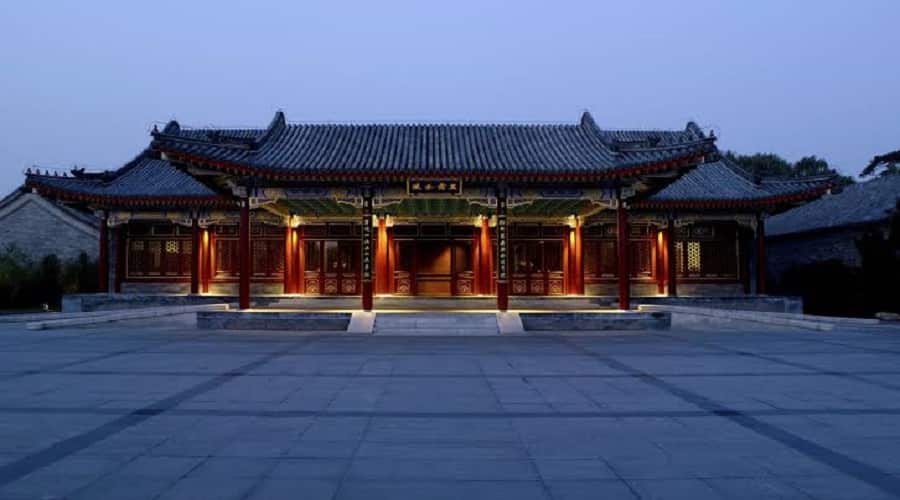
In the north-western part of Beijing, in 20 kilometers from the city center, there is the most beautiful and bright attraction – The Imperial Court. It was built 800 years ago. In various literature and guides you can find another name – The Garden of Peace and Harmony.
Summer Palace is a park area of about three thousand square meters. It includes pavilions, temples and halls, which spread around the beautiful Kunming Lake. The most interesting fact is that water covers three-quarters of the Imperial Palace. Garden of Peace and Harmony served as the residence of the Chinese rulers. Kunming Lake plays an extremely important role in the transport links to the surrounding area of Beijing. It also helps to supply the city with water.
The Imperial Palace is a principal example of both the classic oriental landscape art and landscape architecture. Only at this point such beauty that combines skillful design, natural perfection, architectural splendor and large sizes can be observed. Summer Palace combines the perfect symbiosis of artificial and natural beauty. Visiting this grand historical attraction will leave a lasting impression in the memory of every tourist.
Forbidden City (Imperial Palace)
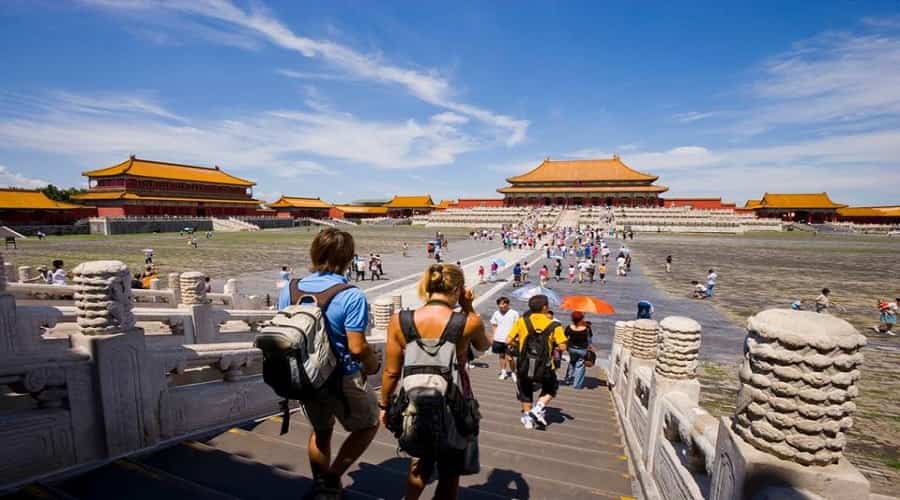
Forbidden City in Beijing is a huge palace complex. this place was declared as a World Heritage Site in the year 1987. It is listed under UNESCO for being home to the largest collection of preserved ancient wooden structures in the world. This palace complex is made in the best traditions of Chinese architecture of the 15th century. It has always been the ceremonial and political center of the great Chinese empire. This Forbidden City has numerous names which takes you to several interesting tourist attractions. The most popular ones are “Forbidden City” and “The Palace of the former rulers”.
The palace complex consists of 980 buildings. It has 8707 rooms. They say that there are 999 buildings. It has a symbolic meaning. Number 9 is sacred to the Chinese people. It is a bond of heaven to the earth. Thus, this number can be commonly met in other elements of the palace ensemble. For example, in all gates have nine rivets. The total area of Palace is 720 thousand square meters.
This place is striking in its beauty, which is mainly reflected in the amazing architecture. The special charm of the complex gives unmatched balustrade of white marble, and the railings and columns, which are decorated with intricate carvings. You can talk for a long time about the splendor of the Forbidden City. Therefore, you must definitely see it with your own eyes.
Beihai Park (Beihai Gongyuan)
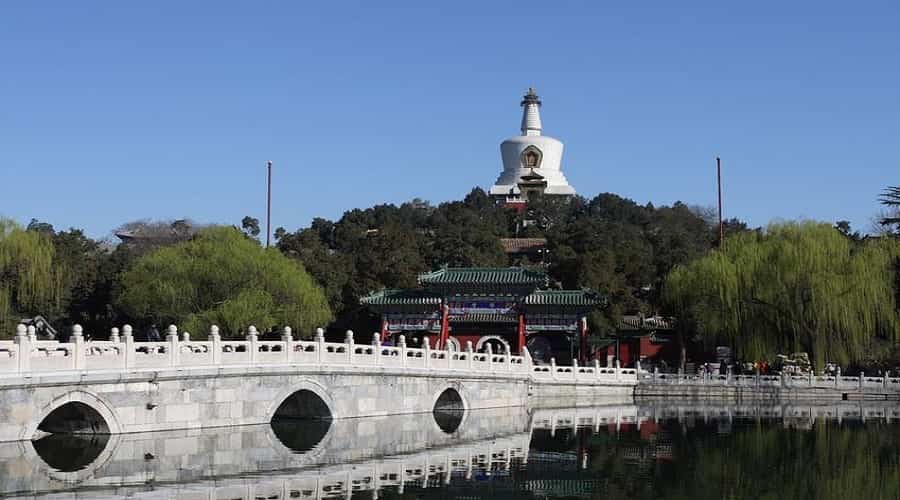
Beihai Park is one of the three links in the chain of Three Lakes Park. It is located in the heart of Beijing. Many famous writers have already described compelling beauty of this park with a thousand-year history in their works. On the area of 68 hectares a majority of the region is covered by a lake in the central part within which there is a peacefully Jade Island. Lama Tower, which is 35.9 meters height, gives a special charm to the whole composition of Beihai Park. It’s made of dazzling white limestone. It is surrounded by galleries and pavilions from all sides. Another property of the park is a unique structure called the Five Dragon Pavilions. It are decorated and painted with unparalleled luxury.
The Dragon Wall is the brightest and the most colorful pearl in Beihai Park. It is located near the pavilions. Among the distinctive features of the Five Dragon Pavilions are tiles.
Ancient pines are a special property of the park. They have been growing around Beijing for more than 800 years. They were planted during the reign of the Jin Dynasty.
In Beihai Park you can always find majesty, tranquility and beauty. It is a once in a lifetime kind of experience.
Nanluoguxiang
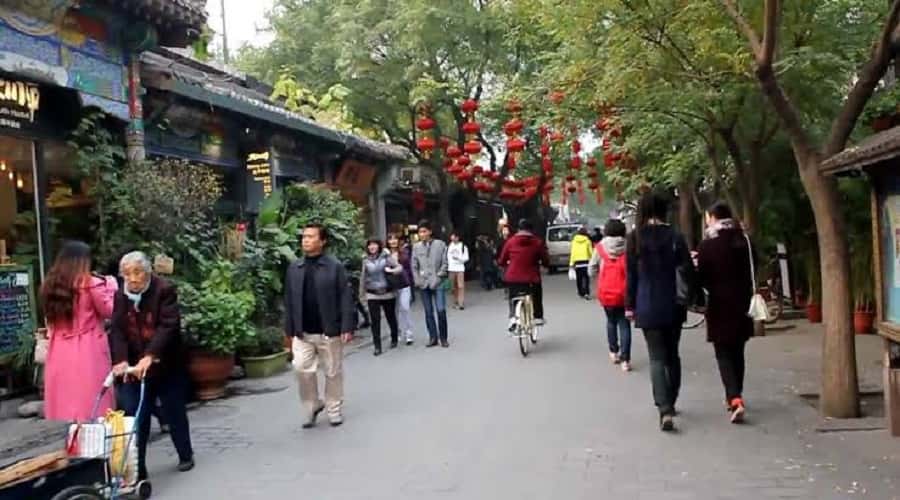
Nanluoguxiang is an ancient district of Beijing. Despite the fact that this place is famed for being one of the oldest neighborhoods in the city, and successfully attracts tourists from all over the world., for more than 800 years there have been taking place various rage events that set the pace to modern life in the city.
The main attractions of the area are ancient hutongs, which form narrow cozy streets. Hutongs are ancient buildings that have reserved their original appearance. They provide an opportunity to see how Beijing looked like hundreds years ago. These structures were built in the period of the rule of Ming and Qing Dynasties in 13-19 century.
Nanluoguxiang has a rich history. This ancient city is located in the heart of Beijing. It attracts tourists from all over the world with its unique atmosphere of comfort. Only here you can feel the true spirit of the Chinese people.
Modern Nanluoguxiang does not resemble that one of the middle Ages. Only hutongs left from former times. Now streets are full of trendy shops, bars and restaurants. Here you can update your wardrobe and try Chinese cuisine. The flow of tourists and locals here never stops. Nanluoguxiang became so popular during the Olympics in 2008 in Beijing.
Dashanzi Art District and 798 Space
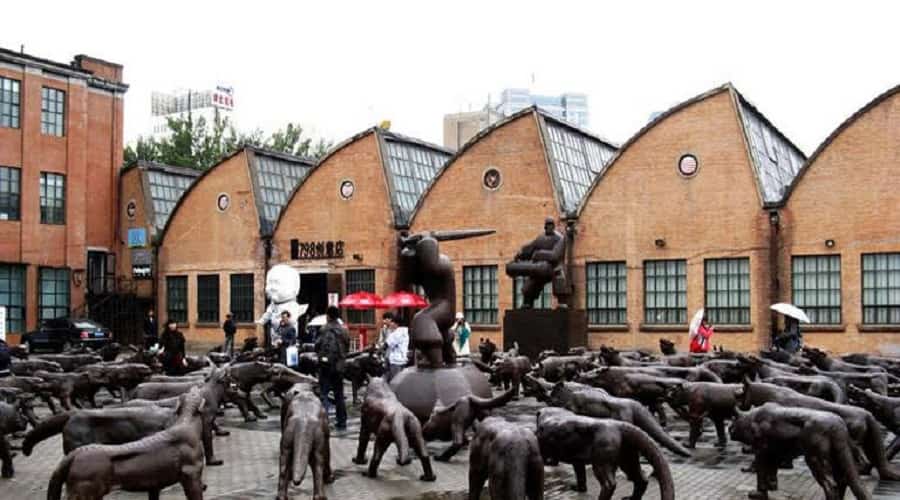
In the north-east of Beijing there is Dashanzi Art District. It is a nook of art. It is the most authoritative and largest art district in the country. In the mid-1950s there was a factory for the production of electronics at number 798. This number is quite symbolic for Beijingers. It means striving, open nature, adventure and creativity.
Life of contemporary art district “798” began from the times of the decline of electronics factory. At that time the considerable part of buildings was empty. Later artists and organizations engaged in contemporary art settled here. Since that time, the factory premises turned into full-fledged working picture galleries, artists’ studios, art centers. Now there are also many trendy shops, bars and restaurants here.
Quarter “798” forms a sort of new space. Creativity and a new way of life with much work, art and inspiration dominate here. Art district became “home” and creative start for young artists and all creative people of these days.
Ming Tombs
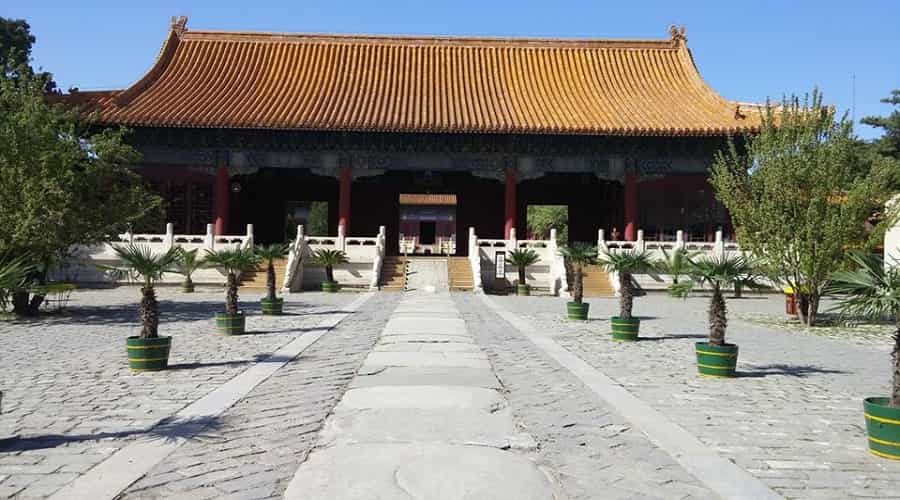
Ming tombs are one of the most important and greatest attractions in China. The complex of mausoleums of thirty emperors of the Ming Dynasty is located in fifty kilometers from Beijing. It is situated at the foot of the Heavenly Longevity Mountain. The complex covers an area of 40 square meters.
The location for the tombs was chosen with great care and according to all the Feng Shui rules. The Mausoleum is surrounded by mountains on three sides. The fourth side is open. It goes to the Beijing Plain. The road that leads to the grave is guarded by Tiger Hill – on the left, and the Hill of the Dragon – on the right. There is a memorial Arch in less than two kilometers from the road. It is made of pure white marble. There are also six columns and five supporting floors, which are decorated with luxurious stone carvings in the form of lions, dragons and lotus flowers.
When passing the Big Red Gate, you can see the Stele Pavilion surrounded by marble columns on all sides. Throughout the mausoleum there are a huge number of sculptures. Each place holds their own purpose and meaning.. The alley that leads to the graves is crowned by Dragon Gate and Phoenix Gate. The site is also included in UNESCO World Heritage List.
Lama Temple (Yonghegong)
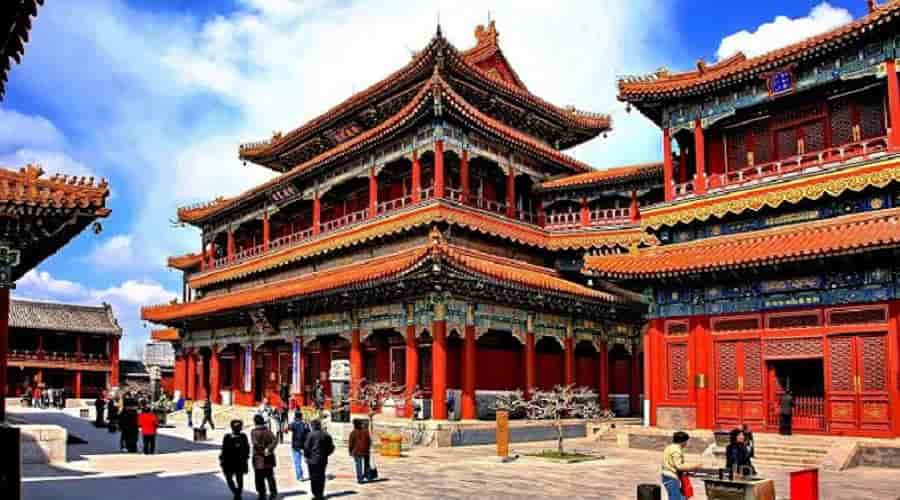
Lama Temple is the largest and the most important monastery for the China Tibetan Buddhist. The Palace of Peace and Reconciliation is an architectural ensemble. It consists of several separate and connected buildings. It occupies an area of 15 hectares. Most of the buildings from the outside are lined with glazed tiles in classic red and yellow colors. House of worship of the temple is surrounded by low walls. They also were painted in red. There is an arched gate near the main entrance.
Different architectural styles such as Mongolian, Tibetan, Manchu and Chinese are clearly seen in the composition of the Palace Lama. The strict symmetry of compositional elements is particularly striking. Gates are located exactly opposite the gate, yards are in front of yards, and halls are in front of comparable buildings. They all are similar in both size and value.
The Hall of Harmony and Peace, the Hall of Heavenly Kings, the Hall of Everlasting Blessings, the Hall of the Dharma Wheel, and the Pavilion of Infinite Happiness impress the most.
Each of the Lama Temple rooms is dedicated to one or several Buddhist gods. There are several different sculptures.. There is always harmony and serenity in the Palace Lama, despite the fact that there it is always overcrowded.
Olympic Park
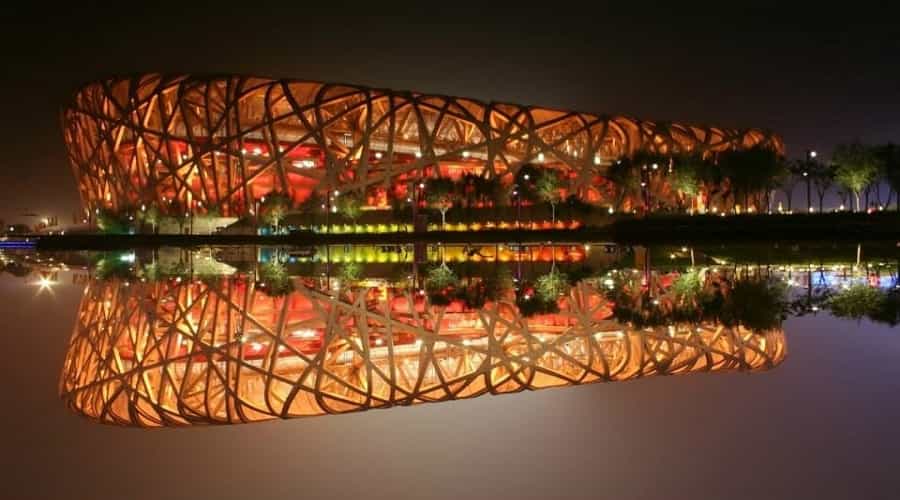
The Olympic Park in Beijing is located in the northern part of the city. It forms a solid central axis with old buildings of the capital. The park was built for the Olympic Games in Beijing in 2008. The total area of the Olympic Complex is 1135 hectares, of which 680 hectares are forest parks. There are also some buildings set aside for the organization of competitions. Olympic Center consists of a sports stadium, which seats for 91,000 people, an indoor stadium, designed for twenty thousands of spectators, and a swimming center, which can accommodate 17,000 people.
All these structures form a grandiose architectural ensemble, which has become a real decoration of Beijing, while not distorting the general view of the city and the beautiful panorama. Best architects managed to combine both ancient temples and such a modern building as the Olympic Park.
Sasaki Associates Incorporated was the author of the project of construction of the Olympic Complex. It also became the winner at the world competition of the Olympic projects in 2002 in Beijing.
National Museum of China
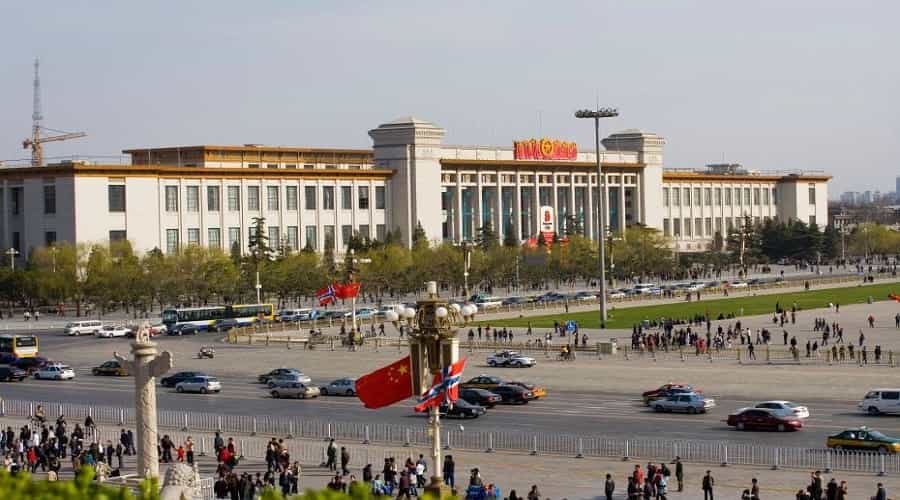
National Museum of China ranks first in attendance throughout the world. Such popularity is due to the huge collection, which is dedicated to art, history and culture of China.
The National Museum is the largest among the museums of history and art in the world. It consists of 28 exhibition halls. Please note that the terms of exhibits savings and visitors stay in the museum fully correspond to international standards.
The exposition of the Chinese Museum houses over 6,020,000 valuable pieces. They cover the period of China history for more than 5000 years. Some specimens have an age of about 1.7 million years.
The Museum is proud of its massive and rich collection. Exterior side of the museum is used to set the unique timepieces. This timer counts the minutes until the various events of national and special importance start. This watch was used as a countdown timer for several times. The first time was dedicated to the proclamation of the independence of Hong Kong in 1997. The second is devoted to the transfer of sovereignty of Macau from the Portuguese Republic to the People’s Republic of China in 1999. The third time countdown timer was used during the opening of the Olympic Games in 2008. And finally, for the last time the watch was used during the largest in history by size, attendance, and international participants Shanghai World Expo 2010.
Bell and Drum Towers (Hutong)
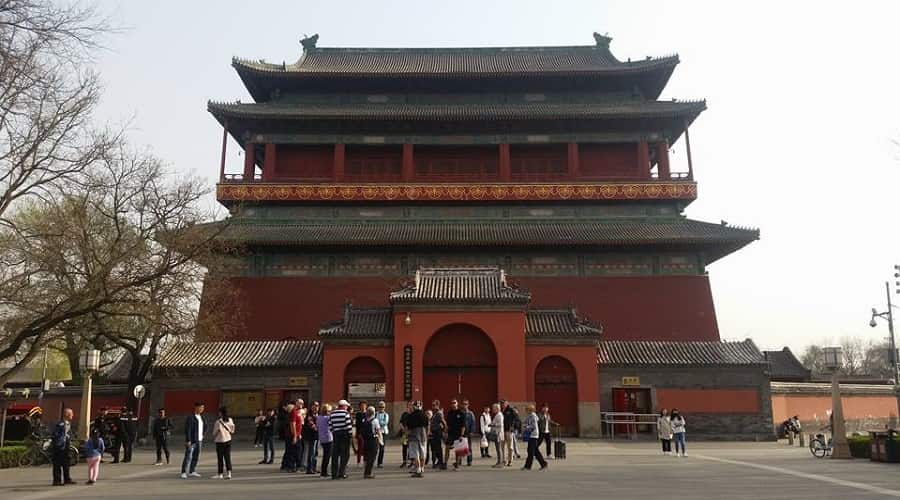
Life of old Beijing is inherently associated with the Bell and Drum Tower. The residents of hutongs wake up to the ringing of bells and fall asleep after drumming.
These two towers were of great importance in the life of Beijing. They were intended for time settling during the reign of the Qing, the Ming, and Yuan Dynasties. Both towers are spaced apart at a distance of one hundred meters. They tower over the city, like watchdogs.
You can enjoy a concert on the old drums around the Drum Tower. It is performed by local musicians. There is also a pretty interesting exhibition, which is located directly in the tower. It is devoted to the measurement of time in ancient China. Magnificent views of the city and the Bell tower can be observed from the terrace on the top floor of the Drum Tower.
The Bell Tower is distinctive, stylish and elegant. The construction is made in gray with dark tiles. At the top of the tower there is a huge bronze bell. The Bell Tower courtyard is decorated with stone pillars, which are ornamented with carvings in the form of lions, flowers and herbs. Nowadays this tower serves as the collecting, study and exhibition place of ancient bells.
Temple of Heaven Park (Tiatan Park)
Temple of Heaven is the huge altar complex, which was built 500 years ago. It is located to the south of the center of Beijing. The complex has an interesting shape. The southern part of Temple of Heaven is of square form. It symbolizes the forces of the Earth. The northern part is round, which means the celestial powers. The roofs of the main buildings of the complex are covered with glazed tiles of heavenly color.
Heavenly Temple consists of three parts:
The first part is a marble altar. It was erected in 1530. The special charm of this construction gives a three-round-shaped terrace. It is made of white marble slabs. Three steps symbolize the earth, heaven and the human element.
The second part of the Temple of Heaven is the Pavilion of the firmament. It is surrounded by a circular wall on all sides. This structure is featured by the well-known triple echo stones. They are stacked in front of the steps leading to the hall of the Haunts Yuyuy temple.
The third part of the Temple of Heaven is the Hall of Reaping Prayers. It was built in 1420. The Harvest Prayer Book impresses with its architectural splendor. It is a round building that sheltered with three-tiered roof with blue tiles. It is also decorated with gilded tower.
The Temple of Heaven is a perfect piece of art. For more than a hundred years, it has impressed its visitors with unsurpassed beauty.

 Call
Call WhatsApp
WhatsApp Enquiry
Enquiry